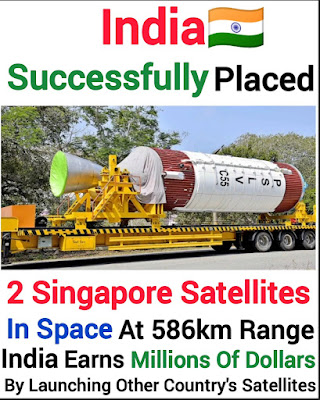Isro’s PSLV successfully places 2 Singapore satellites into orbit
The Indian Space Research Organisation (Isro) on Saturday successfully placed two Singaporean satellites, TeLEOS-2 and Lumelite-4, in orbit aboard the trusted Polar Satellite Launch Vehicle, while also carrying out experiments with seven payloads attached to its PS4 upper stage, the space agency said.
PSLV- C55/TeLEOS-2 mission is accomplished successfully. In a textbook launch, the vehicle placed TeLEOS-2 and LUMELITE-4 satellites precisely into their intended 586 km circular orbit,” Isro tweeted on Saturday evening.
The launch took place from the Satish Dhawan Space Centre on Saturday at 2.19pm. The mission marked the 57th flight of PSLV and the 16th mission using the PSLV Core Alone configuration, the lightest version of the launch vehicle as it has four core stages and no strap-on boosters to provide an added thrust, Isro said.
Science minister Jitendra Singh congratulated the space agency for another successful mission. “Kudos to Isro for the successful launch of PSLV-C55/TeLEOS-2 mission,” Singh said after the launch.
Nearly 20 minutes after being launched, PSLV-C55 placed TeLEOS-2 in an orbit 586km above earth. After that, the 16kg Lumelite-4 was also placed into the desired orbit. The TeLEOS-2 satellite has been developed under a partnership between the Defence Science and Technology Agency of Singapore and ST Engineering, a Singaporean technology and engineering group. Once deployed and operational, it will be used to support satellite imagery requirements of various agencies in Singapore. TeLEOS-2 carries a Synthetic Aperture Radar (SAR) payload. It will provide all-weather day and night coverage.
The Lumelite-4 satellite has been co-developed by the Institute for Infocomm Research of A*STAR and Satellite Technology and Research Centre of the National University of Singapore. Lumelite-4 is an advanced 12U satellite developed for the technological demonstration of the high-performance space-borne VHF data exchange system. It aims to augment Singapore’s electronic navigation maritime safety systems.
The mission also had a PSLV Orbital Experimental Module, where the spent PS4 stage of the launch vehicle would be utilized as an orbital platform to carry out scientific experiments through non-separating payloads.
Speaking to the media after the launch Isro chairman S Somnath said the first uncrewed Geosynchronous Satellite Launch Vehicle (GSLV) rocket is expected to be launched in February 2024 as part of the Gaganyaan mission.
Before that, there will be two key tests for the mission, which is expected in the coming months.
In December last year, Singh said India’s maiden human space flight, Gaganyaan, was being targeted to be launched in the fourth quarter of 2024. He said then that the uncrewed G1 mission is targeted to be launched in the last quarter of 2023, followed by the second uncrewed G2 mission in the second quarter of 2024, before the final human space flight H1 mission in the fourth quarter of 2024.
Isro’s Gaganyaan project envisages demonstration of human space flight capability by launching crew of three members to an orbit of 400km for a three-day mission and bring them back safely to earth by landing in Indian sea waters.



Comments
Post a Comment